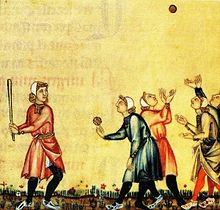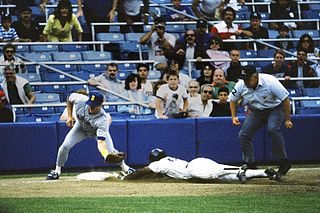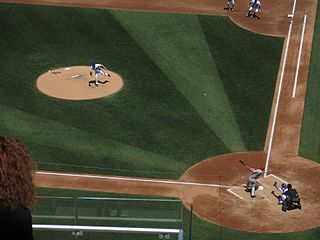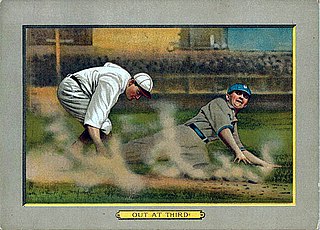
Bat-and-ball games (or safe haven games [1] ) are field games played by two opposing teams. Action starts when the defending team throws a ball at a dedicated player of the attacking team, who tries to hit it with a bat and run between various safe areas in the field to score runs (points). The defending team can use the ball in various ways against the attacking team's players to force them off the field when they are not in safe zones, and thus prevent them from further scoring. [2] [3] The best known modern bat-and-ball games are cricket and baseball, with common roots in the 18th-century games played in England.
Contents
- History
- Types of bat-and-ball games
- Common features
- Running rules
- Strategy
- Player roles
- Scoring
- Elimination of batting players
- Delivery of the ball
- Field
- Game length
- Terminology
- Equipment
- Informal variants
- Tournaments
- List of bat-and-ball games
- Mainstream sports
- Other games
- Hybrid bat-and-ball games
- Games without a bowler/pitcher
- Non-bat-and-ball games
- Related games
- See also
- References
- External links
The teams alternate between "batting" (offensive role), sometimes called "in at bat" or simply in, and "fielding" (defensive role), also called "out in the field" or out. [4] Only the batting team may score, but teams have equal opportunities in both roles. The game is counted rather than timed. The action starts when a player on the fielding team (the "bowler" or "pitcher") [5] puts the ball in play with a delivery whose restriction depends on the game. [6] A player on the batting team attempts to strike the delivered ball, commonly with a "bat", which is a club whose dimensions and other aspects are governed by the rules of the game. If the ball is not fairly delivered to the batter (i.e. not thrown within his reach), then penalties generally occur that help the batting team score. [7] [8]
The batter generally has an obligation to hit certain balls that are delivered within his reach (i.e. balls aimed at a designated area, known as the strike zone or wicket), [9] and must hit the ball so that it is not caught by a fielder before it touches the ground. [10] [11] The most desirable outcome for the batter is generally to hit the ball out of the field, as this results in automatically scoring runs; [12] [13] however, in certain bat-and-ball games, this can result in a penalty against the batter. [14] [15] If the ball is struck into the field, then the batter may become a runner trying to reach a safe haven or "base"/"ground". [16] [17] While in contact with a base, the runner is "safe" from the fielding team and in a position to score runs. Leaving a safe haven places the runner in danger of being put out (eliminated). The teams switch roles when the fielding team 'puts out'/'gets out' enough of the batting team's players, which varies by game.
In modern baseball, the fielders put three players out. [18] In cricket, they "dismiss" all players but one, [19] though in some forms of cricket, there is a limit on the number of deliveries (scoring opportunities) that each team can have, such that the fielding team can become the batting team without getting anyone out. [20] In many forms of early American baseball (townball, roundball), a single out ended the inning. Some games permit multiple runners and some have multiple bases to run in sequence. Batting may occur, and running begin (and potentially end), at one of the bases. The movement between those "safe havens" is governed by the rules of the particular sport. The game ends when the losing team has completed the maximum number of innings (batting/scoring turns), which may range from 1 (as in limited-overs cricket) to 9 (as in baseball) or more. [21] [22] Ties are generally broken (if at all) by allowing each team to have an additional turn to score. [23] [24]
Some variations of bat-and-ball games do not feature bats, with batters instead using parts of their bodies to hit the ball; these variations may also give the batter possession of the ball at the start of each play, eliminating the defensive team's role in starting the action. A prominent example of this is Baseball5, one of the main sporting disciplines governed by the World Baseball Softball Confederation along with baseball and softball. [25] [26]













